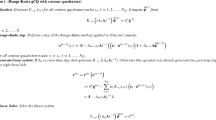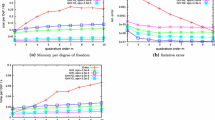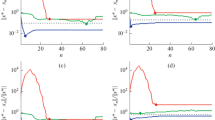Abstract
The Galerkin–Chebyshev matrix is the coefficient matrix for the Galerkin method (or the degenerate kernel approximation method) using Chebyshev polynomials. Each entry of the matrix is defined by a double integral. For convolution kernels K(x-y) on finite intervals, this paper obtains a general recursion relation connecting the matrix entries. This relation provides a fast generation of the Galerkin–Chebyshev matrix by reducing the construction of a matrix of order N from N 2+O(N) double integral evaluations to 3N+O(1) evaluations. For the special cases (a) K(x-y)=|x-y|α-1(-ln|x-y|)p and (b) K(x-y)=K ν(σ|x-y|) (modified Bessel functions), the number of double integral evaluations to generate a Galerkin–Chebyshev matrix of arbitrary order can be further reduced to 2p+2 double integral evaluations in case (a) and to 8 double integral evaluations in case (b).
Similar content being viewed by others
References
M. Abramowitz and I.A. Stegun, eds., Handbook of Mathematical Functions, Applied Mathematics Series 55 (National Bureau of Standards, Washington, DC, 1972).
K.E. Atkinson and I.H. Sloan, The numerical solution of first-kind logarithmic-kernel integral equations on smooth open arcs, Math. Comp. 56 (1991) 119-139.
S. Coen, D. Cope and D.E. Tallman, Diffusion current at a band electrode by an integral equation method, J. Electroanal. Chem. 215 (1986) 29-48.
D. Cope, C.H. Scott, U. Kalapathy and D.E. Tallman, Transient behavior at planar microelectrodes. Diffusion current at a band electrode by an integral equation method. Part II, J. Electroanal. Chem. 280 (1990) 27-35.
D. Cope, C.H. Scott and D.E. Tallman, Transient behavior at planar microelectrodes. Diffusion current at ring electrodes by the integral equation method, J. Electroanal. Chem. 285 (1990) 49-70.
D.K. Cope and D.E. Tallman, An integral equation method for computing transient current at microelectrodes, J. Electroanal. Chem. 396 (1995) 265-276.
S.O. Engblom, D.K. Cope and D.E. Tallman, Diffusion current at the tubular band electrode by the integral equation method, J. Electroanal. Chem. 406 (1996) 23-31.
G.M.L. Gladwell and S. Coen, A Chebyshev approximation method for microstrip problems, IEEE Trans. Microwave Theory and Techniques 23 (1975) 865-870.
R. Kress, Linear Integral Equations(Springer, Berlin, 1989).
Y. Xu and Y. Zhao, Quadratures for boundary integral equations of the first kind with logarithmic kernels, J. Integral Equations Appl. 8 (1996) 239-268.
Y. Yan and I.H. Sloan, On integral equations of the first kind with logarithmic kernels, J. Integral Equations Appl. 1 (1988) 549-579.
Author information
Authors and Affiliations
Rights and permissions
About this article
Cite this article
Cope, D.K. Recursive generation of the Galerkin–Chebyshev matrix for convolution kernels. Advances in Computational Mathematics 9, 21–35 (1998). https://doi.org/10.1023/A:1018933305810
Issue Date:
DOI: https://doi.org/10.1023/A:1018933305810




